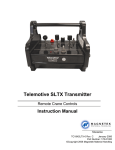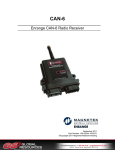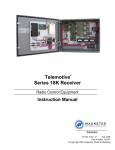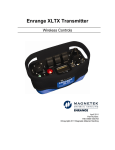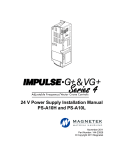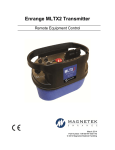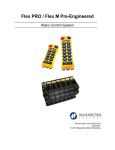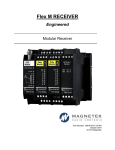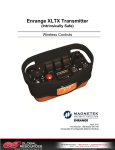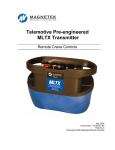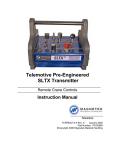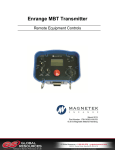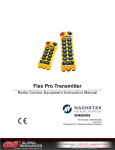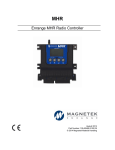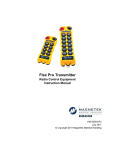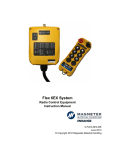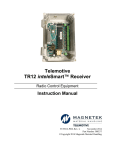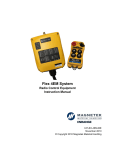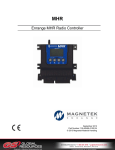Download User Manual - GS Global Resources
Transcript
Flex VUE™ Transmitter Remote Equipment Control July 2013 Part Number: 198-80200-0001 R4 © 2013 Magnetek Material Handling Your New Radio Remote Thank you for your purchase of Magnetek’s Flex VUE™ Radio Remote Equipment Control. Magnetek has set a whole new standard in radio-remote performance, dependability, and value with this unique new line of handheld transmitters. If your product ever needs modification or service, please contact one of our representatives at the following locations: U.S. Service Information For questions regarding service or technical information contact: +1.866.MAG.SERV +1.866.624.7378 International Service +1.262.783.3500 World Headquarters: Magnetek, Inc. N49 W13650 Campbell Drive Menomonee Falls, WI 53051 Telephone: Website: e-mail: +1.800.288.8178 www.magnetekmh.com [email protected] Fax Numbers: Main: +1.800.298.3503 Sales: +1.262.783.3510 Service: +1.262.783.3508 Canada Service Information: 4090B Sladeview Crescent Mississauga, Ontario L5L 5Y5 Canada Phone: +1.800.792.7253 Fax: +1.905.828.5707 +1.416.424.7617 (24/7 Service pager) EU Market Contact: Brian Preston Magnetek (UK) Ltd. 20 Drakes Mews, Crownhill Milton Keynes, MK8 0ER UK Phone: +44.1908.261427 Fax: +44.1908.261674 ©2013 MAGNETEK All rights reserved. This notice applies to all copyrighted materials included with this product, including, but not limited to, this manual and software embodied within the product. This manual is intended for the sole use of the person(s) to whom it was provided, and any unauthorized distribution of the manual or dispersal of its contents is strictly forbidden. This manual may not be reproduced in whole or in part by any means whatsoever without the expressed written permission of MAGNETEK. Flex VUE™ Transmitter Instruction Manual July 2013 Page 2 of 41 TABLE OF CONTENTS 1.0 INTRODUCTION ................................................................................................................................ 5 1.1 PRODUCT MANUAL SAFETY INFORMATION ............................................................................ 5 2.0 WARNINGS AND CAUTIONS ........................................................................................................... 6 2.1 CRITICAL INSTALLATION CONSIDERATIONS ........................................................................... 7 2.2 GENERAL ....................................................................................................................................... 7 2.3 PERSONS AUTHORIZED TO OPERATE RADIO CONTROLLED MACHINERIES ..................... 7 2.4 SAFETY INFORMATION AND RECOMMENDED TRAINING FOR RADIO CONTROLLED EQUIPMENT OPERATORS ..................................................................................................................... 8 2.5 TRANSMITTER UNIT ..................................................................................................................... 9 2.6 PRE-OPERATION TEST ................................................................................................................ 9 2.7 HANDLING BATTERIES .............................................................................................................. 10 2.8 OPTIONAL RECHARGABLE BATTERY CHARGING ................................................................. 10 2.9 BATTERY DISPOSAL .................................................................................................................. 10 3.0 FLEX VUE™ TRANSMITTER STANDARD CONFIGURATON AND OPERATION ....................... 11 3.1 INSTALLING BATTERY COMPARTMENT .................................................................................. 14 3.1.1 Alkaline Battery Replacement ............................................................................................... 14 3.2 TURNING THE TRANSMITTER ON AND OFF ........................................................................... 15 3.2.1 Turning On the Transmitter ................................................................................................... 15 3.2.2 Proportional Button Calibration ............................................................................................. 16 3.2.3 Pulling In the Machine Stop Relay ........................................................................................ 16 3.2.4 Turning Off the Transmitter ................................................................................................... 16 3.2.5 Removing Power Switch Key ................................................................................................ 17 3.3 MACHINE STOP SWITCH (FOR EMERGENCY STOPPING ONLY) ......................................... 17 3.4 USING PUSHBUTTONS FOR OPERATION ............................................................................... 17 3.4.1 Proportional Push Button Control .......................................................................................... 17 3.4.2 2-Step Push Button Control................................................................................................... 17 3.5 NORMAL OPERATING MODE – DISPLAY FEATURES/FUNCTIONS ...................................... 17 3.5.1 Watch Dog Indicator (Sweeping Dot) .................................................................................... 18 3.5.2 Max Button Output Indicator (Percentage) ............................................................................ 18 3.5.3 Battery Life Indicator ............................................................................................................. 18 3.5.4 Command Confirmation ........................................................................................................ 18 3.5.5 Signal Strength Indicator ....................................................................................................... 19 3.5.6 Two-Way Feedback System ................................................................................................. 19 3.6 NORMAL OPERATING MODE – STATUS LED indications ........................................................ 19 4.0 TRANSMITTER SETUP ................................................................................................................... 20 4.1 USING THE TRANSMITTER IN SETUP MODE .......................................................................... 20 4.2 ENTERING SETUP MODE .......................................................................................................... 20 4.2.1 Entering Setup During Start Up ............................................................................................. 20 4.2.2 Entering Setup During Normal Operation ............................................................................. 20 4.3 ADJUSING SETTINGS IN SETUP MODE ................................................................................... 21 4.3.1 Access Code ......................................................................................................................... 21 4.3.2 Channel Select ...................................................................................................................... 21 4.3.3 RF Power............................................................................................................................... 21 4.3.4 Transmitter Inactivity Timeout ............................................................................................... 22 4.3.5 Backlight Power % ................................................................................................................ 22 4.3.6 Backlight Timeout .................................................................................................................. 22 4.3.7 Set Clock ............................................................................................................................... 23 4.3.8 Password Enable .................................................................................................................. 23 4.3.9 Change Password ................................................................................................................. 23 4.3.10 IR Configuration Receiver ..................................................................................................... 23 4.3.11 Exit With Save ....................................................................................................................... 24 4.3.12 Exit Without Save .................................................................................................................. 24 5.0 OPTIONAL PROGRAMMING WITH RCP ....................................................................................... 25 July 2013 Page 3 of 41 Flex VUE™ Transmitter Instruction Manual 5.1 ACCESS CODES ......................................................................................................................... 25 5.2 CONNECTING THE FLEX VUE™ TO A COMPUTER ................................................................ 25 5.3 PROGRAMMING WITH RCP ....................................................................................................... 26 5.3.1 FLEX VUE™ Configuration Page.......................................................................................... 29 5.3.2 Saving, Downloading, and Reading the Programs and Other RCP Software Functions...... 32 6.0 CLEANING THE TRANSMITTER ......................................................................................................... 34 7.0 TRANSMITTER RF CHANNEL CONFIGURATION SETTINGS ..................................................... 35 7.1 FCC STATEMENTS ..................................................................................................................... 35 7.2 CHANNEL AND FREQUENCY DESIGNATIONS BY COUNT .................................................... 36 7.3 OPTIONAL FREQUENCIES AND CHANNELS ........................................................................... 37 7.3.1 2.4 GHz: FHSS ...................................................................................................................... 37 7.3.2 433 MHz Telemotive Legacy Channel Set: TMS .................................................................. 37 7.3.3 419 MHz Extended Channel Set: TMS ................................................................................. 38 8.0 TROUBLESHOOTING ..................................................................................................................... 39 8.1 GENERAL TROUBLESHOOTING ............................................................................................... 39 8.2 ASSEMBLY AND REPLACEMENT PARTS ................................................................................ 40 9.0 EU DECLARATION OF CONFORMITY ............................................................................................... 41 Flex VUE™ Transmitter Instruction Manual July 2013 Page 4 of 41 1.0 INTRODUCTION Thank you for your purchase of Magnetek’s Flex VUE™ Radio Remote Equipment Control. These instructions are to be used as a reference for personnel operating the Flex VUE™ Radio Remote Equipment Control and the equipment that this Flex VUE™ Radio Remote Equipment Control is attached to. The user of these instructions should have basic knowledge in the handling of electronic equipment. 1.1 PRODUCT MANUAL SAFETY INFORMATION Magnetek, Inc. (Magnetek) offers a broad range of radio remote control products, control products and adjustable frequency drives, and industrial braking systems for overhead material handling applications. This manual has been prepared by Magnetek to provide information and recommendations for the installation, use, operation and service of Magnetek’s material handling products and systems (Magnetek Products). Anyone who uses, operates, maintains, services, installs or owns Magnetek Products should know, understand and follow the instructions and safety recommendations in this manual for Magnetek Products. The recommendations in this manual do not take precedence over any of the following requirements relating to cranes, hoists and lifting devices: Instructions, manuals, and safety warnings of the manufacturers of the equipment where the radio system is used, Plant safety rules and procedures of the employers and the owners of facilities where the Magnetek Products are being used, Regulations issued by the Occupational Health and Safety Administration (OSHA), Applicable local, state or federal codes, ordinances, standards and requirements, or Safety standards and practices for the overhead material handling industry. This manual does not include or address the specific instructions and safety warnings of these manufacturers or any of the other requirements listed above. It is the responsibility of the owners, users and operators of the Magnetek Products to know, understand and follow all of these requirements. It is the responsibility of the owner of the Magnetek Products to make its employees aware of all of the above listed requirements and to make certain that all operators are properly trained. No one should use Magnetek Products prior to becoming familiar with and being trained in these requirements. WARRANTY INFORMATION FOR INFORMATION ON MAGNETEK’S PRODUCT WARRANTIES BY PRODUCT TYPE, PLEASE VISIT WWW.MAGNETEKMH.COM. Flex VUE™ Transmitter Instruction Manual July 2013 Page 5 of 41 2.0 WARNINGS AND CAUTIONS Throughout this document WARNING and CAUTION statements have been deliberately placed to highlight items critical to the protection of personnel and equipment. WARNING – A warning highlights an essential operating or maintenance procedure, practice, etc. which, if not strictly observed, could result in injury or death of personnel, or long term physical hazards. Warnings are highlighted as shown below: WARNING CAUTION – A caution highlights an essential operating or maintenance procedure, practice, etc. which if not strictly observed, could result in damage to, or destruction of equipment, or loss of functional effectiveness. Cautions are highlighted as shown below: CAUTION WARNINGS and CAUTIONS SHOULD NEVER BE DISREGARDED. The safety rules in this section are not intended to replace any rules or regulations of any applicable local, state, or federal governing organizations. Always follow your local lockout and tagout procedure when maintaining any radio equipment. The following information is intended to be used in conjunction with other rules or regulations already in existence. It is important to read all of the safety information contained in this section before installing or operating the Radio Control System. Flex VUE™ Transmitter Instruction Manual July 2013 Page 6 of 41 2.1 CRITICAL INSTALLATION CONSIDERATIONS WARNING PRIOR TO INSTALLATION AND OPERATION OF THIS EQUIPMENT, READ AND DEVELOP AN UNDERSTANDING OF THE CONTENTS OF THIS MANUAL AND THE OPERATION MANUAL OF THE EQUIPMENT OR DEVICE TO WHICH THIS EQUIPMENT WILL BE INTERFACED. FAILURE TO FOLLOW THIS WARNING COULD RESULT IN SERIOUS INJURY OR DEATH AND DAMAGE TO EQUIPMENT. ALL EQUIPMENT MUST HAVE A MAINLINE CONTACTOR INSTALLED AND ALL TRACKED CRANES, HOISTS, LIFTING DEVICES AND SIMILAR EQUIPMENT MUST HAVE A BRAKE INSTALLED. FAILURE TO FOLLOW THIS WARNING COULD RESULT IN SERIOUS INJURY OR DEATH AND DAMAGE TO EQUIPMENT. AN AUDIBLE AND/OR VISUAL WARNING MEANS MUST BE PROVIDED ON ALL REMOTE CONTROLLED EQUIPMENT AS REQUIRED BY CODE, REGULATION, OR INDUSTRY STANDARD. THESE AUDIBLE AND/OR VISUAL WARNING DEVICES MUST MEET ALL GOVERNMENTAL REQUIREMENTS. FAILURE TO FOLLOW THIS WARNING COULD RESULT IN SERIOUS INJURY OR DEATH AND DAMAGE TO EQUIPMENT. FOLLOW YOUR LOCAL LOCKOUT TAGOUT PROCEDURE BEFORE MAINTAINING ANY REMOTE CONTROLLED EQUIPMENT. ALWAYS REMOVE ALL ELECTRICAL POWER FROM THE CRANE, HOIST, LIFTING DEVICE OR SIMILAR EQUIPMENT BEFORE ATTEMPTING ANY INSTALLATION PROCEDURES. DEENERGIZE AND TAGOUT ALL SOURCES OF ELECTRICAL POWER BEFORE TOUCH-TESTING ANY EQUIPMENT. FAILURE TO FOLLOW THIS WARNING COULD RESULT IN SERIOUS INJURY OR DEATH AND DAMAGE TO EQUIPMENT. THE DIRECT OUTPUTS OF THIS PRODUCT ARE NOT DESIGNED TO INTERFACE DIRECTLY TO TWO STATE SAFETY CRITICAL MAINTAINED FUNCTIONS, I.E., MAGNETS, VACUUM LIFTS, PUMPS, EMERGENCY EQUIPMENT, ETC. A MECHANICALLY LOCKING INTERMEDIATE RELAY SYSTEM WITH SEPARATE POWER CONSIDERATIONS MUST BE PROVIDED. FAILURE TO FOLLOW THIS WARNING COULD RESULT IN SERIOUS INJURY OR DEATH OR DAMAGE TO EQUIPMENT. 2.2 GENERAL Radio controlled material handling equipment operates in several directions. Cranes, hoists, lifting devices and other material handling equipment can be large, and operate at high speeds. Quite frequently, the equipment is operated in areas where people are working in close proximity to the material handling equipment. The operator must exercise extreme caution at all times. Workers must constantly be alert to avoid accidents. The following recommendations have been included to indicate how careful and thoughtful actions may prevent injuries, damage to equipment, or even save a life. 2.3 PERSONS AUTHORIZED TO OPERATE RADIO CONTROLLED MACHINERIES Only properly trained persons designated by management should be permitted to operate radio controlled equipment. Radio controlled cranes, hoists, lifting devices and other material handling equipment should not be operated by any person who cannot read or understand signs, notices and operating instructions that pertain to the equipment. Radio controlled equipment should not be operated by any person with insufficient eyesight or hearing or by any person who may be suffering from a disorder or illness, is taking any medication that may cause loss of equipment control, or is under the influence of alcohol or drugs. July 2013 Page 7 of 41 Flex VUE™ Transmitter Instruction Manual 2.4 SAFETY INFORMATION AND RECOMMENDED TRAINING FOR RADIO CONTROLLED EQUIPMENT OPERATORS Anyone being trained to operate radio controlled equipment should possess as a minimum the following knowledge and skills before using the radio controlled equipment. The operator should: have knowledge of hazards pertaining to equipment operation have knowledge of safety rules for radio controlled equipment have the ability to judge distance of moving objects know how to properly test prior to operation be trained in the safe operation of the radio transmitter as it pertains to the crane, hoist, lifting device or other material handling equipment being operated have knowledge of the use of equipment warning lights and alarms have knowledge of the proper storage space for a radio control transmitter when not in use be trained in transferring a radio control transmitter to another person be trained how and when to report unsafe or unusual operating conditions test the transmitter emergency stop and all warning devices prior to operation; testing should be done on each shift, without a load be thoroughly trained and knowledgeable in proper and safe operation of the crane, hoist, lifting device, or other material handling equipment that utilizes the radio control know how to keep the operator and other people clear of lifted loads and to avoid “pinch” points continuously watch and monitor status of lifted loads know and follow cable and hook inspection procedures know and follow the local lockout and tagout procedures when servicing radio controlled equipment know and follow all applicable operating and maintenance manuals, safety procedures, regulatory requirements, and industry standards and codes The operator shall not: lift or move more than the rated load operate the material handling equipment if the direction of travel or function engaged does not agree with what is indicated on the controller use the crane, hoist or lifting device to lift, support or transport people lift or carry any loads over people operate the crane, hoist or lifting device unless all persons, including the operator, are and remain clear of the supported load and any potential pinch points operate a crane, hoist or lifting device when the device is not centered over the load July 2013 Page 8 of 41 Flex VUE™ Transmitter Instruction Manual operate a crane, hoist or lifting device if the chain or wire rope is not seated properly in the sprockets, drum or sheave operate any damaged or malfunctioning crane, hoist, lifting device or other material handling equipment change any settings or controls without authorization and proper training remove or obscure any warning or safety labels or tags leave any load unattended while lifted leave power on the radio controlled equipment when the equipment is not in operation operate any material handling equipment using a damaged controller because the unit may be unsafe operate manual motions with other than manual power operate radio controlled equipment when low battery indicator is on WARNING THE OPERATOR SHOULD NOT ATTEMPT TO REPAIR ANY RADIO CONTROLLER. IF ANY PRODUCT PERFORMANCE OR SAFETY CONCERNS ARE OBSERVED, THE EQUIPMENT SHOULD IMMEDIATELY BE TAKEN OUT OF SERVICE AND BE REPORTED TO THE SUPERVISOR. DAMAGED AND INOPERABLE RADIO CONTROLLER EQUIPMENT SHOULD BE RETURNED TO MAGNETEK FOR EVALUATION AND REPAIR. FAILURE TO FOLLOW THIS WARNING COULD RESULT IN SERIOUS INJURY OR DEATH AND DAMAGE TO EQUIPMENT. 2.5 TRANSMITTER UNIT Transmitter switches should never be mechanically blocked ON or OFF. When not in use, the operator should turn the transmitter OFF. A secure storage space should be provided for the transmitter unit, and the transmitter unit should always be placed there when not in use. This precaution will help prevent unauthorized people from operating the material handling equipment. Spare transmitters should be stored in a secure storage space and only removed from the storage space after the current transmitter in use has been turned OFF, taken out of the service area and secured. 2.6 PRE-OPERATION TEST At the start of each work shift, or when a new operator takes control of the equipment, operators should do, as a minimum, the following steps before making lifts with any crane or hoist: Test all warning devices. Test all direction and speed controls. Test all functions Test the transmitter emergency stop. Flex VUE™ Transmitter Instruction Manual July 2013 Page 9 of 41 2.7 HANDLING BATTERIES WARNING KNOW AND FOLLOW PROPER BATTERY HANDLING, CHARGING AND DISPOSAL PROCEDURES. IMPROPER BATTERY PROCEDURES CAN CAUSE BATTERIES TO EXPLODE OR DO OTHER SERIOUS DAMAGE. FAILURE TO FOLLOW THIS WARNING COULD RESULT IN SERIOUS INJURY OR DEATH AND DAMAGE TO EQUIPMENT. Use only batteries approved by Magnetek for the specific product. Do not dispose of a battery pack in fire; it may explode. Do not attempt to open a sealed battery pack. Do not short circuit the battery. Keep the battery pack environment cool and dry during storage (i.e., not in direct sunlight or close to a heat source). Do not submerge the battery pack or otherwise cause it to become wet. 2.8 OPTIONAL RECHARGABLE BATTERY CHARGING For those transmitters equipped with rechargeable batteries and battery chargers, all users shall be familiar with the instructions of the charger before attempting to use. Do not attempt to charge non-rechargeable battery packs in the charger. Avoid charging partially discharged rechargeable batteries to help prolong battery cycle life. Do not charge batteries in a hazardous environment. Keep the battery pack environment cool during charging (i.e., not in direct sunlight or close to a heat source). Do not short the charger. Do not attempt to charge a damaged battery. Use only Magnetek approved chargers for the appropriate battery pack. Do not attempt to use a battery that is leaking, swollen, or corroded. Charger units are not intended for outdoor use. Only use charger units indoors. 2.9 BATTERY DISPOSAL Before disposing of batteries consult local and governmental regulatory requirements for proper disposal procedure. Flex VUE™ Transmitter Instruction Manual July 2013 Page 10 of 41 3.0 FLEX VUE™ TRANSMITTER STANDARD CONFIGURATON AND OPERATION WARNING BEFORE OPERATING THE TRANSMITTER, FAMILIARIZE YOURSELF WITH ALL SAFETY INFORMATION IN THIS MANUAL, THE CORRESPONDING RECEIVER SYSTEM MANUAL, APPROPRIATE MANUAL SUPPLEMENTS AND ANY OTHER LOCAL, STATE, OR FEDERAL RULES OR REGULATIONS ALREADY IN EXISTENCE. FAILURE TO FOLLOW THIS WARNING COULD RESULT IN SERIOUS INJURY OR DEATH AND DAMAGE TO EQUIPMENT. Figure 1: Typical Flex VUE™ 4 Button Configuration G. Graphic Display 2. Pushbutton #2 SB. Strap Bar E. Machine Stop Button 3. Pushbutton #3 IR. IR Communication Window LED. Status LED Indicator 4. Pushbutton #4 SN. System Information S. Removable Power Key Switch LG. Logo Label BC. Battery Compartment 1. Pushbutton #1 Flex VUE™ Transmitter Instruction Manual July 2013 Page 11 of 41 Figure 2: Typical Flex VUE™ 8 Button Configuration G. Graphic Display 3. Pushbutton #3 LG. Logo Label E. Machine Stop Button 4. Pushbutton #4 SB. Strap Bar LED. Status LED Indicator 5. Pushbutton #5 IR. IR Communication Window S. Removable Power Key Switch 6. Pushbutton #6 SN. System Information 1. Pushbutton #1 7. Pushbutton #7 BC. Battery Compartment 2. Pushbutton #2 8. Pushbutton #8 Flex VUE™ Transmitter Instruction Manual July 2013 Page 12 of 41 Figure 3: Typical Flex VUE™ 12 Button Configuration G. Graphic Display 4. Pushbutton #4 11. Pushbutton #11 E. Machine Stop Button 5. Pushbutton #5 12 .Pushbutton #12 LED. Status LED Indicator 6. Pushbutton #6 LG. Logo Label S. Removable Power Key Switch 7. Pushbutton #7 SB. Strap Bar 1. Pushbutton #1 8 .Pushbutton #8 IR. IR Communication Window 2. Pushbutton #2 9. Pushbutton #9 SN. System Information 3. Pushbutton #3 10. Pushbutton #10 BC .Battery Compartment Flex VUE™ Transmitter Instruction Manual July 2013 Page 13 of 41 3.1 INSTALLING BATTERY COMPARTMENT Prior to utilizing the Flex VUE™ transmitter, batteries must be installed. 3.1.1 Alkaline Battery Replacement The Flex VUE™ comes standard with a removable battery compartment that holds two disposable AA alkaline batteries. Figure 4: Flex VUE™ Alkaline Battery Compartment To change the alkaline batteries in the battery compartment, separate the compartment from the outer housing (see Figure 4) by loosening all four screws (Phillips bit) on the battery compartment and replace the batteries with new ones. Orient the batteries according to the battery orientation diagrams on the inside of the battery compartment. Figure 5: Separated Alkaline Battery Pack When reinserting the compartment into the outer housing, make sure to align the compartment so that it fully seats. If the compartment will not seat, it is oriented upside down; flip the compartment over and it will fully seat. After fully seating the battery compartment into the outer housing, tighten the four screws on the outside edges of the compartment until the compartment is flush to the outside housing. NOTE: Maximum torque for battery compartment screws should not exceed 5 in-lbs. Figure 6: Installation of Battery compartment into Flex VUE™ transmitter Flex VUE™ Transmitter Instruction Manual July 2013 Page 14 of 41 3.2 TURNING THE TRANSMITTER ON AND OFF The Flex VUE™ uses both a three position rotary switch labeled either OFF-ON-START or OFF-ONSPEED and a Machine Stop switch to turn the transmitter on or off. Figure 7: Machine Stop Switch and OFF-ON-START/SPEED rotary 3.2.1 Turning On the Transmitter First, the Machine Stop switch must be in the raised position or the pulled out position (see Section 3.3 for Machine Stop Switch operation). Next, insert the black power switch key into the power key slot located on the right side of the transmitter just below the display. Rotate the key clockwise to the ON position, and the Magnetek logo will appear on the LCD screen. Following the logo screen, the unit will perform a routine initialization. Figure 8: Machine Stop Switch and OFF-ON-START rotary July 2013 Page 15 of 41 Flex VUE™ Transmitter Instruction Manual During initialization, the Flex VUE™ scans for any switches or motions that may be on during power up. If any switches or motions are on (with the exception of the OFF-ON-START rotary switch), the failure will be displayed on the screen, allowing you to recalibrate the switches if necessary. The Flex VUE™ will power down only if the switch fault is resolved with recalibration (see Section 3.2.2 on how to recalibrate the unit). The unit will need to be turned off if the switch fault cannot be resolved. See Section 3.2.4 for details on how to turn off the unit. NOTE: If recalibrating the button does not fix the problem, then the button may be stuck or otherwise defective. Contact the factory for repair. After a successful initialization, the Flex VUE™ will enter the Normal Operation Mode and display the normal operating screen. See Section 3.5 for more information on the Normal Operation Mode. NOTE: Holding the OFF-ON-START rotary switch in the START position for more than five seconds during startup will put the device into Setup Mode. The START position is not required for turning on the transmitter for normal use. 3.2.2 Proportional Button Calibration NOTE: On Flex VUE™ units equipped with 2-step buttons, calibration is not required. The buttons on the Flex VUE™ are calibrated when the unit is assembled in the factory, but if the Flex VUE™ unit is experiencing problems, the buttons can be recalibrated after assembly by using the following procedure: Proportional Buttons: 1. With the switch in the OFF position, press and hold Buttons 1 and 4 and turn the unit on. When the unit displays Button Calibration, release Buttons 1 and 4. The calibration numbers for each button will be displayed, showing the button number, the minimum value, and the maximum value (these are decimal values). The LED should be green. 2. Slowly press the button that needs to be calibrated. When the LED turns red, the minimum value can be set by putting the rotary switch into the START position. The LED should now be blue; release the rotary switch from the START position. 3. Press the current button all the way down to set the maximum value for the button. Release this button and repeat the process on any other buttons that need to be calibrated. 4. Once all of the buttons that need to be calibrated have been completed, hold the OFF-ONSTART switch in the START position and push buttons 3 and 4. If the user does not want to save the new calibration information, then the OFF-ON-START switch can be turned to the OFF position to revert to the old calibration data. After pushing the buttons, the user will then be prompted to release them. This will save the calibration data and put the unit back into normal operation. 3.2.3 Pulling In the Machine Stop Relay Once the Flex VUE™ has been turned on (as described in Section 3.2.1) and is in the Normal Operating Mode, the Machine Stop relay in the receiver can be pulled in by turning the OFF-ON-START rotary switch to the START position and then releasing. 3.2.4 Turning Off the Transmitter The transmitter can be turned off by rotating the OFF-ON-START switch to the OFF position. Once turned off, the Machine Stop relay in the receiver is immediately opened. July 2013 Page 16 of 41 Flex VUE™ Transmitter Instruction Manual NOTE: During shutdown, the transmitter display will indicate that the shutdown sequence is being performed. Once the shutdown sequence is complete, the transmitter display will turn off. NOTE: Depressing the Machine Stop switch will also turn the transmitter off and open the Machine Stop relay in the receiver. See Section 3.3 for more information on the Machine Stop switch. 3.2.5 Removing Power Switch Key The black power switch key can be removed from the transmitter when not in use to prevent unauthorized use. To remove the power switch key from the transmitter, fully rotate the key counter-clockwise one click past the OFF position, and then pull the key straight out of the transmitter. 3.3 MACHINE STOP SWITCH (FOR EMERGENCY STOPPING ONLY) The Machine Stop Switch is the red button located on the left side of the transmitter just below the display. When the Machine Stop Switch is depressed, the Machine Stop relay in the receiver is immediately opened. Under normal operating conditions, the Machine Stop Switch must be in the raised position or the transmitter and system will not operate. To release the Machine Stop Switch, rotate the red button of the switch either clockwise or counterclockwise. The red button will pop up on its own when the button is rotated enough. NOTE: The Machine Stop Switch is to be used for emergency stopping only, not for normal system shutdown. 3.4 USING PUSHBUTTONS FOR OPERATION The Flex VUE™ units come equipped with either proportional push buttons for control or 2-step push buttons. 3.4.1 Proportional Push Button Control On Flex VUE™ units equipped with proportional push buttons, the buttons can be set up to deliver a control signal output that increases in proportion to how far the push button is depressed. NOTE: The proportional push buttons can be programmed at the factory to deliver a digital output for simple on/off commands. 3.4.2 2-Step Push Button Control On Flex VUE™ units equipped with 2-Step push buttons, the buttons can be set up to deliver a control signal output that increases with each step that the button is depressed. 3.5 NORMAL OPERATING MODE – DISPLAY FEATURES/FUNCTIONS In normal operating mode, the Flex VUE™ displays real time information relating to the operation of the transmitter on the graphic user interface. Information may include Command Confirmation, Battery Life, Signal Strength, Two-Way Feedback, etc. July 2013 Page 17 of 41 Flex VUE™ Transmitter Instruction Manual Figure 9: Normal operating screen on graphic user interface 3.5.1 Watch Dog Indicator (Sweeping Dot) The Watch Dog Indicator is located on the far right of the bottom status line of the Flex VUE™ graphic user interface screen. The 4 pixel sweeping dot will start in the right corner of the screen, moving toward the upper left corner of the screen, stopping while still on the bottom line, and then return to the right corner of the screen. The watch dog indicator should always be moving, but will move at different rates depending on how much the transmitter is doing. NOTE: The dot should be continuously sweeping at all times. If the dot is stationary (not sweeping), the transmitter needs to be power-cycled to operate properly. 3.5.2 Max Button Output Indicator (Percentage) NOTE: This indicator is only present on Flex VUE™ units equipped with proportional buttons. Flex VUE™ units equipped with 2-step buttons will show no indication (the indication will be blank). Located between the Watch Dog Indicator and the Battery Life Indicator on the bottom of the graphic user interface screen, this indicator shows the maximum value of the proportional button output. This value can be 25%, 50%, 75%, and 100%. 3.5.3 Battery Life Indicator Remaining battery life is displayed in the bottom center of the graphic user interface screen. Battery life is displayed in 10% increments. 3.5.4 Command Confirmation Each time the user operates a control on the transmitter, a message will be displayed on the Flex VUE™ graphic user interface screen showing the operation defined in the transmitter (that relates to the receiver) and the value of the pushed button. This corresponds to the value being sent to the receiver. For a 2-step button transmitter, if button number 2 is depressed fully, the display might show ‘BTN2 Step 2’, which translates to ‘Button 2, speed 2’ being sent to the receiver. For a proportional button transmitter, the display might show “Boom Up: 85%”, sending this message to the receiver to raise the boom at 85% of maximum rate. Flex VUE™ Transmitter Instruction Manual July 2013 Page 18 of 41 3.5.5 Signal Strength Indicator The Signal Strength Indicator is located on the bottom line of the Flex VUE™ graphic user interface screen, between the number of messages being received and the Battery Life Indicator. The Signal Strength Indicator shows the radio signal strength at the receiver, and is only available in systems equipped for Two-Way feedback (see Section 3.5.6). For such systems, the signal strength being shown on the Flex VUE™ screen is the signal strength seen by the receiver. NOTE: The signal strength indictor is only shown on systems that have two-way feedback enabled. 3.5.6 Two-Way Feedback System This option allows the user to view various parameters that may be important to the operation of the equipment on the graphic user interface display screen. Parameters such as engine RPM, the torque or speed of a drive, temperature, current, or any other useful values can be sent from the receiver and displayed on the transmitter. 3.6 NORMAL OPERATING MODE – STATUS LED INDICATIONS In normal operating mode, the status LED will illuminate to provide instant feedback on the status of the Flex VUE™ transmitter. The descriptions of the status LED illuminations are as follows: Flashing Green: Functioning normally Flashing Blue: Functioning normally and connected to receiver (only if two-way feedback is available and enabled) Flashing Red: Error or low battery (check display for details) NOTE: Systems not configured for Two-Way feedback will not utilize the flashing Blue LED function. Flex VUE™ Transmitter Instruction Manual July 2013 Page 19 of 41 4.0 TRANSMITTER SETUP The transmitter may have settings changed in one of two ways: by using either the Setup Mode on the transmitter itself, or by connecting the transmitter to a computer and using the optional RCP software. Configuration settings that can be changed are shown in Section 4.3. All of the same settings can be changed with the optional RCP software. 4.1 USING THE TRANSMITTER IN SETUP MODE The Setup Mode can be used to edit configuration settings; the values that can be changed are shown in Section 4.3. Some parameter changes will take effect immediately, while others will require a restart of the Flex VUE™ transmitter. This will be explained in Section 4.3. 4.2 ENTERING SETUP MODE The Setup Mode can be entered in one of two ways, as explained in Sections 4.2.1 and 4.2.2. If the password has been enabled, the password will need to be entered to get to the setup screen. The password is set to Enabled by default at the factory. The factory default password is set to ‘0000’. The value for the password can be changed once in the setup screen (Sections 4.3.8 and 4.3.9). To enter the password, you need to press button 1 (to increment) or button 2 (to decrement) to change the password value. Once the value is set, press the START switch to move to the next entry position. Once the password is successfully entered the transmitter will show the setup screen. NOTE: If the password is entered incorrectly, the device will display that the password is invalid and then exit out of the Setup Mode. 4.2.1 Entering Setup During Start Up To enter the Setup Mode during startup of the transmitter, first make sure the unit is OFF and the Machine Stop Switch is raised. Next, turn the OFF-ON-START rotary switch clockwise to the START position and hold it there until the ‘Entering Setup’ screen appears. When the ‘Entering Setup’ screen appears, release the START switch. If password is enabled, it will need to be entered here. In this mode, there will not be any information on the top line of the Flex VUE™ (since communication with the receiver has not yet been enabled). One of the setup parameters will be displayed on the screen, with ‘Setup Mode’ being displayed toward the bottom of the screen. 4.2.2 Entering Setup During Normal Operation To enter the Setup Mode during normal operation of the transmitter, first make sure the unit is not controlling a device under load, as radio messaging will always be disabled during Setup Mode. Next, turn the OFF-ON-START rotary switch clockwise to the START position and hold it there, then depress buttons 1 and 2 (the top row of buttons) at the same time until the setup screen appears. If the password is enabled, it will need to be entered here. Flex VUE™ Transmitter Instruction Manual July 2013 Page 20 of 41 In this mode, the top line of the display will show ‘Com Disabled’ to indicate that radio communication to the receiver had been initiated before Setup Mode was entered. Radio communication will be enabled after leaving Setup Mode. One of the setup parameters will be displayed on the screen, and ‘Setup Mode’ will be displayed toward the bottom of the screen. 4.3 ADJUSING SETTINGS IN SETUP MODE To navigate through Setup Mode, the buttons designated button 1 and button 2 (top row of buttons) and the OFF-ON-START switch are used. Buttons 1 and 2 cycle through the menus and are also used to change parameters within the menus. Rotating the OFF-ON-START switch to the START position will toggle between the menu and its parameter(s). NOTE: No parameter changes will take effect until the user has selected ‘Save and Exit’ from the Setup Mode. 4.3.1 Access Code The Access Code determines which receiver will be controlled by the transmitter. The Access Code in the Flex VUE™ transmitter must match the receiver Access Code. If the Access Code settings on the receiver and transmitter do not match, no communication will occur. The Access Code is a 20-bit binary value with a decimal equivalent of 0 - 1048575. If Setup Mode is entered using the sequence in Section 4.2.1, then the value entered into this parameter will be used after selecting ‘Save And Exit’ from the Setup Mode menu without having to restart the Flex VUE™. If Setup Mode was entered using the sequence in Section 4.2.2, then the Flex VUE™ will need to be power-cycled to start using the new parameter after ‘Save And Exit’ from the Setup Mode menu is selected. 4.3.2 Channel Select The Channel Select setting determines the radio frequency that the Flex VUE™ is operating on. The user can select from multiple channels within the base system frequency; the channel numbers and corresponding frequencies are listed in Sections 7.2 and 7.3. If Setup Mode is entered using the sequence in Section 4.2.1, then the value entered into this parameter will be used after selecting ‘Save And Exit’ from the Setup Mode menu without having to restart the Flex VUE™. If Setup Mode was entered using the sequence in Section 4.2.2, then the Flex VUE™ will need to be power-cycled to start using the new parameter after ‘Save And Exit’ from the Setup Mode menu is selected. 4.3.3 RF Power The RF Power setting determines the RF output of the transmitter. The user can select values of “Min Power”, ”1/4 Power”, ”1/2 Power”, and ” Max Power”. If Setup Mode is entered using the sequence in Section 4.2.1, then the value entered into this parameter will be used after selecting ‘Save And Exit’ from the Setup Mode menu without having to restart the Flex VUE™. If Setup Mode was entered using the sequence in Section 4.2.2, then the Flex VUE™ will need to be power-cycled to start using the new parameter after ‘Save And Exit’ from the Setup Mode menu is selected. July 2013 Page 21 of 41 Flex VUE™ Transmitter Instruction Manual 4.3.4 Transmitter Inactivity Timeout This setting controls the amount of time that the transmitter can be inactive before it automatically shuts off. The Timeout time can be set from Disabled to 60 minutes. From Disabled to 15 minutes the timeout can be set in 1 minute increments. From 15 minutes to 60 minutes it can be set in 5 minute increments. When the unit times out, the transmitter will turn off. The Flex VUE™ unit will need to be turned off and then back on to start the unit again. If ‘Save and Exit’ is selected from the setup menu after changing this parameter, it will immediately take effect. WARNING DO NOT ASSUME THE POWER IS OFF IN THE RECEIVER BECAUSE THE TRANSMITTER IS TURNED OFF. FAILURE TO FOLLOW THIS WARNING COULD RESULT IN SERIOUS INJURY OR DEATH AND DAMAGE TO EQUIPMENT. 4.3.5 Backlight Power % The Backlight Power percentage setting controls the brightness of the backlight on the Flex VUE™ transmitter. The Backlight Power can be set from ‘Backlight Off’ (0%) to 100%, in 5% increments. If ‘Save and Exit’ is selected from the setup menu after changing this parameter, it will immediately take effect. 4.3.6 Backlight Timeout The Backlight Timeout setting controls the amount of time that the backlight will stay on after a command is pressed before it automatically shuts off. Backlight Timeout can be set from ‘Always On’ to 30 seconds, in 1 second increments. If ‘Save and Exit’ is selected from the setup menu after changing this parameter, it will immediately take effect. NOTE: Leaving the backlight on longer will decrease the battery run time and will require more frequent battery replacement. July 2013 Page 22 of 41 Flex VUE™ Transmitter Instruction Manual 4.3.7 Set Clock This sets the system clock for the Flex VUE™ unit. The clock is set in the following format: 10/01/12 13:12:11 MM/DD/YY hh:mm:ss If ‘Save and Exit’ is selected from the setup menu after changing this parameter, it will immediately take effect. 4.3.8 Password Enable This setting enables or disables the requirement of entering a password into the transmitter to enter Setup Mode. When the disabled setting is selected the user will go directly into Setup Mode without being prompted to enter a password. Magnetek strongly recommends enabling the Setup Mode password to prevent unauthorized or accidental changes to parameters. If ‘Save and Exit’ is selected from the setup menu after changing this parameter, it will immediately take effect. NOTE: The unit is shipped with the password requirement enabled and utilizing the factory default password. 4.3.9 Change Password This allows the user to change the password needed to enter the Setup Mode. The password must consist of four digits. If ‘Save and Exit’ is selected from the setup menu after changing this parameter, it will immediately take effect. 4.3.10 IR Configuration Receiver The IR Cfg Recv function in the Setup Mode allows the transmitter to link to a compatible receiver by using IR (contact the factory to determine if your receiver is compatible), and automatically set up the channel and access code to match the linked compatible receiver. CAUTION THE IR CONFIGURATION FUNCTION WILL ONLY UPDATE CHANNEL AND ACCESS CODE INFORMATION IF THE RECEIVER AND TRANSMITTER ARE PROGRAMMED AT THE FACTORY WITH THE SAME PROJECT IDENTIFICATION NUMBER. IF THE RECEIVER/TRANSMITTER PAIRING IS NOT PROGRAMMED WITH THE SAME PROJECT IDENTIFICATION NUMBER, THE GRAPHIC USER INTERFACE WILL DISPLAY “ERR PROJECT ID” WHEN AN IR LINK IS ATTEMPTED. THE IR LINK WILL NOT BE SUCCESSFUL AND THE ACCESS CODE AND CHANNEL INFORMATION IN THE TRANSMITTER WILL NOT BE CHANGED. Flex VUE™ Transmitter Instruction Manual July 2013 Page 23 of 41 WARNING IF THE RECEIVER AND TRANSMITTER IR PAIR IS NOT OPERATING IN THE SAME FREQUENCY BAND WHEN AN IR LINK IS ATTEMPTED, THE GRAPHIC USER INTERFACE WILL DISPLAY “ERR RF FREQ”. THE IR LINK WILL NOT BE SUCCESSFUL AND THE ACCESS CODE AND CHANNEL INFORMATION IN THE TRANSMITTER WILL NOT BE CHANGED. To utilize this feature, use the following steps: 1. Navigate to the menu function “IR Cfg Recv”. 2. Aim the IR window (on the back of the device) towards the IR window of the receiver. 3. Move the OFF-ON-START switch to the START position and release. 4. The user will then have 5 seconds to ensure the IR windows of the transmitter and receiver are lined up while the Flex VUE™ will countdown from five to zero. 5. After the countdown has reached zero, the interface will display “Attempting” while attempting to communicate with the receiver. 6. Upon successful communication with the receivers, the interface will display “Success”. 7. If the communication was unsuccessful, the interface will display “Failed”. The interface may not display “Attempting” if the transmitter and receiver communicate successfully with each other upon their initial attempt. NOTE: The changes to the transmitter’s channel configuration and access code will not be saved until the operator selects the ‘Exit with Save’ option to exit the Setup Mode. If the receiver is not in range, the scan will time out and the graphic user interface will display “Failed.” The operator can reposition the transmitter and reattempt to establish the IR link with the receiver by toggling the START position on the OFF-ON-START switch multiple times. NOTE: The access code and channel will not be updated to match the desired receiver until “Success” is displayed. Once “Success” is displayed, subsequent “Failed” messages will not overwrite the access code and channel obtained in the successful IR link until a new successful IR link is made. 4.3.11 Exit With Save Selection of this option saves all changes and exits the Setup Mode. 4.3.12 Exit Without Save If the user does not wish to save any of the configuration changes made, the ‘Exit Without Save’ option can be selected. NOTE: None of the changes will be saved upon selection of this option. The transmitter will start up with the last saved configuration settings. Flex VUE™ Transmitter Instruction Manual July 2013 Page 24 of 41 5.0 OPTIONAL PROGRAMMING WITH RCP Using the optional RCP software makes programming of the Flex VUE™ easier and allows for settings to be saved for future reference. WARNING THE USE OF RCP (RADIO CONTROL PROGRAMMER) IS INTENDED FOR USE BY AUTHORIZED PERSONS ONLY. CHANGES TO ANY RADIO DATA VALUE MAY LEAD TO UNEXPECTED, UNDESIRABLE, OR UNSAFE OPERATION OF EQUIPMENT AND FURTHERMORE MAY LEAD TO EQUIPMENT DAMAGE, PERSONAL INJURY, OR EVEN DEATH. ALL EQUIPMENT OPERATORS AND/OR PERSONNEL SHOULD BE NOTIFIED OF ANY RADIO DATA VALUE CHANGES THAT MAY AFFECT OPERATION. 5.1 ACCESS CODES The receiver and transmitter must be programmed with the same access code to properly communicate with each other. WARNING TWO OPERATIONAL TRANSMITTERS WITH THE SAME ACCESS CODES OPERATING AT THE SAME TIME IS A DEFINITE SAFETY HAZARD. FAILURE TO FOLLOW THIS WARNING COULD RESULT IN SERIOUS INJURY OR DEATH AND DAMAGE TO EQUIPMENT. 5.2 CONNECTING THE FLEX VUE™ TO A COMPUTER The Flex VUE™ transmitter contains circuitry that permits communication with a computer system via USB. The USB mini-B plug is located through the battery compartment. July 2013 Page 25 of 41 Flex VUE™ Transmitter Instruction Manual Figure 10: USB mini-B receptacle as viewed through the battery compartment When plugging in the transmitter to a computer system, the transmitter battery compartment must be removed. The USB circuit provides power to the transmitter. After plugging the USB cable in between the computer and the Flex VUE™, the OFF-ON-START switch needs to be moved to the ON position with the Machine Stop switch in the raised position to provide power to the transmitter. 5.3 PROGRAMMING WITH RCP Read the section of the Flex VUE™ manual regarding additional operational features to become familiar with the features listed below. The Flex VUE™ transmitter can be programmed using the optional RCP (Radio Control Programmer) software. Magnetek RCP software makes the programming of the Flex VUE™ transmitter easier and allows the programmer to store all of the Flex VUE™ settings in files for later use or reference. The RCP software also allows the programmer to customize the Flex VUE™ transmitter display with language descriptions that are project or machine specific. Help is provided for each function at the bottom of the RCP screen. The RCP software allows you to select radio channel, access code, transmitter power, etc. Follow the steps below: Install the RCP Software Install the RCP software onto your computer. The software is self-installing; simply insert the CD-ROM into your CD-ROM drive and follow the onscreen prompts. Refer to the installation instruction sheet for help. You will be prompted to enter an activation code. The code can be found on the CD jewel case and on the installation instructions. The software cannot be used without this code. Flex VUE™ Transmitter Instruction Manual July 2013 Page 26 of 41 Run the RCP Software After installation of the RCP Software, double click the RCP icon to launch the program. Click on New Project or Open Project Select “New Project” if you are creating a new program file. Select “Open Project” if you want to retrieve an existing program file. A list of recent projects will appear under “Open Project.” Clicking on one of these will open that project. It is recommended that you create a folder in which to save all programming files. For New Projects, Select Device Type After the New Project icon is selected, a menu will open listing the available device types. Select the device type that matches the product you wish to program (selecting a project type will display a picture of the product for verification). Receive Device Data Checkbox At the bottom of the New Project window there is a check box that allows the user to automatically download the setting values on the device upon connection. July 2013 Page 27 of 41 Flex VUE™ Transmitter Instruction Manual NOTE: This check box is checked by default. Having the “Receive Device Data” option checked will cause the program to automatically read the data that is currently on the device upon clicking the Add button. WARNING IF “RECEIVE DEVICE DATA” CHECK BOX IS UNCHECKED, THE RCP PROGRAM WILL OVERWRITE ALL SETTING VALUES ON THE DEVICE WITH DEFAULT VALUES AND ANY SETTINGS CHANGED BY THE OPERATOR UPON SENDING THE PROGRAM TO THE DEVICE. ALL STORED VALUE SETTINGS WITHIN THE DEVICE WILL BE REPLACED, INCLUDING ANY PROJECT-SPECIFIC VALUES. MAGNETEK STRONGLY RECOMMENDS THAT THE “RECEIVE DEVICE DATA” CHECK BOX BE LEFT CHECKED. This screen also allows the programmer to create a specific name for the device to help keep track of device settings and changes. It is recommended that a unique name is chosen for each device July 2013 programmed with RCP. Page 28 of 41 Flex VUE™ Transmitter Instruction Manual 5.3.1 FLEX VUE™ Configuration Page The Flex VUE™ Transmitter has one configurable page available to change settings on. The page allows the configuration of general transmitter settings (transmitter name, access code, RF channel, etc.). Unit Info Page This page allows the user to view the receiver’s Project ID and serial number. The user can modify the transmitter name, access code, RF channel and activate the password. This page may also be used by the user to synchronize the internal clock on the transmitter with the connected PC or manually set the clock/date. NOTE: Changing any of these details will require a reboot of the Flex VUE™ after the new information has been sent to the device. July 2013 Page 29 of 41 Flex VUE™ Transmitter Instruction Manual Transmitter Name The transmitter name field allows the user to create a custom name for the transmitter. The name can be up to 16 ASCII characters long. Project ID This section displays the Project ID for the unit. The Project ID is set by the factory and cannot be modified by the user. Serial Number This section displays the serial number for the unit. The serial number of the unit is set by the factory and cannot be modified by the user. Access Code The access code acts as the transmitter address. The transmitter will only transmit commands to receivers with the same address. This feature is selectable by the user. NOTE: The transmitter must be set with the same access code as the receiver to properly communicate with each other. WARNING THE ACCESS CODES IN THE RECEIVER ARE UNIQUE AND FACTORY PRESET. DO NOT CHANGE THESE ACCESS CODES UNLESS YOU ARE REPLACING AN EXISTING RECEIVER AND ITS ACCESS CODE. CHANGING THIS CODE COULD MAKE IT COMMON WITH ANOTHER RECEIVER ACCESS CODE, WHICH COULD MOVE OTHER EQUIPMENT. NO TWO SYSTEMS IN ANY LOCATION SHOULD EVER HAVE THE SAME ACCESS CODES INDEPENDENT OF FREQUENCY. FAILURE TO FOLLOW THIS WARNING COULD RESULT IN SERIOUS INJURY OR DEATH, AND DAMAGE TO EQUIPMENT. RF Channel The RF channel is user-selectable through the pull-down menu. This function is used to prevent interference with other radio devices. There are multiple user-selectable channels for 400 MHz, 900 MHz, and 2.4 GHz systems. See Sections 7.2 and 7.3 for channel frequency details. Inactivity Timeout The transmitter can be set to turn off after a period of time when no controls are activated. To restart the transmitter, the OFF-ON-START switch must be cycled through the START position. The factory default setting for the inactivity timeout is 15 minutes. July 2013 Page 30 of 41 Flex VUE™ Transmitter Instruction Manual RF Power The RF transmitting power of the unit is user-selectable through the pull-down menu. This function is used to reduce the operating range of the transmitter from the equipment being operated. The userselectable options for RF power are Full, Half, Quarter, and Minimum. Activate Password The password is used to restrict access to the configuration menu on the Flex VUE™. Having an active password prevents accidental changes to the transmitter. Please familiarize yourself with this section before programming the password. If you choose to enable the password function, you can create a new password by selecting a four digit numerical password using numbers from 0 to 9. Be sure to write this password down in a safe place for future reference. WARNING ALWAYS REMEMBER TO STORE THE PASSWORD IN A SECURE LOCATION FOR ACCESS IF THE PASSWORD IS LOST OR FORGOTTEN. ONCE THE TRANSMITTER IS PROGRAMMED WITH A PASSWORD, THERE IS NO WAY TO DEFEAT THE PASSWORD WITHOUT USING THE RCP SOFTWARE TO EITHER READ THE PASSWORD OR REPROGRAM A NEW PASSWORD. WARNING THIS PASSWORD FUNCTION IS NOT TO BE USED AS A SECURITY DEVICE. THE PURPOSE OF THIS FUNCTION IS TO PREVENT ACCIDENTAL CHANGES TO THE TRANSMITTER SETTINGS. THE BEST FORM OF SECURITY IS ALWAYS TO LOCK UP THE TRANSMITTER WHEN NOT IN SERVICE. FAILURE TO FOLLOW THIS WARNING COULD RESULT IN SERIOUS INJURY OR DEATH AND DAMAGE TO EQUIPMENT. The password default setting is to be disabled during initial programming by the RCP software. To enable password protection, check the box next to the phrase “Activate password.” WARNING NOT ENABLING THE PASSWORD FUNCTION ALLOWS THE TRANSMITTER SETTINGS TO BE MODIFIED BY ANY UNAUTHORIZED USERS. IMPROPER TRANSMITTER SETTINGS COULD RESULT IN SERIOUS INJURY OR DEATH AND DAMAGE TO EQUIPMENT. Flex VUE™ Transmitter Instruction Manual July 2013 Page 31 of 41 Backlight Enable This section allows the user to enable the LCD display backlight (on systems equipped with optional graphic user interface LCD display) and select the period of time after transmitter activity that the backlight stays on. The user has the option to check the “Always On” check box for backlight timeout. If this box is checked, the backlight will remain on continuously while the transmitter is active. NOTE: The longer the backlight is turned on, the shorter the transmitter battery life will be. The user can also enable the backlight to turn off or timeout after a period of time, the user can select the custom field and enter in the time (in seconds) that the backlight should be lit. The range of values is 1 to 30 seconds. Update Transmitter Date/Time This feature allows the user to reset the internal clock on the transmitter to the correct date and time. The user can select to match the clock on the PC that is connected to the unit or select a custom date and time. 5.3.2 Saving, Downloading, and Reading the Programs and Other RCP Software Functions CAUTION TO PROGRAM OR READ DATA FROM THE FLEX VUE™, THE TRANSMITTER MUST BE TURNED ON. Saving the Programming File Once programming is complete click the file tab at the top of the RCP screen to open the file menu. File location and name can be selected from this menu. Old files can be deleted, called up, modified, and renamed by this same menu. Sending a Program to the Flex VUE™ WARNING AFTER EVERY PROGRAMMING OF THE TRANSMITTER, TEST THE UNIT BY UTILIZING THE APPROPRIATE RECEIVER. IF THE RECEIVER DOES NOT RESPOND, DO NOT ACTIVATE A FUNCTION BUTTON! THE TRANSMITTER MAY HAVE INCORRECT PROGRAMMING. RE-CHECK THE PROGRAMMING IN THE TRANSMITTER AND RETEST. AFTER ACTIVATION OF THE RECEIVER, FUNCTIONALLY TEST ALL COMMANDS ON THE TRANSMITTER BY INITIALLY JOGGING THE BUTTONS, THEN WITH A FULL MOVEMENT BEFORE RETURNING TO SERVICE. FAILURE TO FOLLOW THIS WARNING COULD RESULT IN SERIOUS INJURY OR DEATH AND DAMAGE TO EQUIPMENT. Flex VUE™ Transmitter Instruction Manual July 2013 Page 32 of 41 To send a program file to a Flex VUE™ Transmitter 1. Plug in the USB programming cable. 2. Click the “send” button on the RCP screen. A dialog box will pop up confirming that you want to proceed. Check the box marked “I accept,” and then click the button “Continue send to radio.” On-screen prompts will confirm that the receiver has been programmed or if there are any issues. 3. Data will need to be sent separately for the Unit Info and CAN Configuration screens. Receiving (Reading) the Flex VUE™ Programming To read a program file from the Flex VUE™ Transmitter 1. Plug in the USB programming cable. 2. Click “Receive” and follow onscreen prompts. 3. RCP will confirm reception and automatically display current programming in the Flex VUE™ unit. Reading the RCP Software Version 1. Select “Help”. 2. Select “About”. 3. The RCP Software Version number will be displayed. Resetting Flex VUE™ Back to Factory Default Settings 1. Select “Reset to Defaults” button. 2. A dialog box will pop up confirming that you want to proceed. Click the button “OK” to restore the factory default settings. On-screen prompts will confirm that the transmitter has been reset to defaults or if there are any issues. 3. Power cycle the Flex VUE™ transmitter to implement the factory default values. NOTE: Resetting the system back to factory defaults only restores the factory settings for the CAN configuration settings. All other settings will not be altered. July 2013 Page 33 of 41 Flex VUE™ Transmitter Instruction Manual 6.0 CLEANING THE TRANSMITTER When cleaning the transmitter housing, a mild soap/detergent water solution should be used. After wiping the unit with this solution a clean water rinse should be done to remove any residue. NEVER use the following to clean the transmitter: Cleaning fluids with ammonia (such as Windex or Formula 409) Gasoline Denatured Alcohol Carbon tetrachloride Acetone Using the any of the above items to clean the transmitter can cause damage to the transmitter and affect operation. July 2013 Page 34 of 41 Flex VUE™ Transmitter Instruction Manual 7.0 TRANSMITTER RF CHANNEL CONFIGURATION SETTINGS The RF channel can be set via the Setup Mode or the optional RCP software. Sections 7.2 and 7.3 show the RF channels and protocols available for each transmitter radio frequency option. 7.1 FCC STATEMENTS Compliance Statement (Part 15.19) This device complies with Part 15 of FCC rules. Operation is subject to the following two conditions: 1. This device may not cause harmful interference, and 2. This device must accept any interference received, including interference that may cause undesired operation. Warning (Part 15.21) Changes or modifications not expressly approved by the party responsible for compliance should void the user’s authority to operate the equipment. This portable transmitter with its antenna complies with FCC’s RF exposure limits for general population/uncontrolled exposure. July 2013 Page 35 of 41 Flex VUE™ Transmitter Instruction Manual 7.2 CHANNEL AND FREQUENCY DESIGNATIONS BY COUNT 900 MHz: TMS 433 MHz: TMS Channel Count 01) 02) 03) 04) 05) 06) 07) 08) 09) 10) 11) 12) 13) 14) 15) 16) 17) 18) 19) 20) 21) 22) 23) 24) 25) 26) 27) 28) 29) 30) 31) 32) Channel Designator 01 02 03 04 05 06 07 08 09 10 11 12 13 14 15 16 17 18 19 20 21 22 23 24 25 26 27 28 29 30 31 32 Table 1.A Actual Frequency 433.000 MHz 433.050 MHz 433.100 MHz 433.150 MHz 433.200 MHz 433.250 MHz 433.300 MHz 433.350 MHz 433.400 MHz 433.450 MHz 433.500 MHz 433.550 MHz 433.600 MHz 433.650 MHz 433.700 MHz 433.750 MHz 433.800 MHz 433.850 MHz 433.900 MHz 433.950 MHz 434.000 MHz 434.050 MHz 434.100 MHz 434.150 MHz 434.200 MHz 434.250 MHz 434.300 MHz 434.350 MHz 434.400 MHz 434.450 MHz 434.500 MHz 434.550 MHz Channel Count 01) 02) 03) 04) 05) 06) 07) 08) 09) 10) 11) 12) 13) 14) 15) 16) 17) 18) 19) 20) 21) 22) 23) 24) 25) 26) 27) 28) 29) 30) 31) 32) Channel Designator 1 2 3 4 5 6 7 8 A B C D E F G H I J K L M N O P Q R S T U V W X Actual Frequency 903.30 MHz 906.30 MHz 907.80 MHz 909.30 MHz 912.30 MHz 915.30 MHz 919.80 MHz 921.30 MHz 902.30 MHz 904.10 MHz 904.30 MHz 905.10 MHz 905.50 MHz 905.70 MHz 906.60 MHz 908.70 MHz 908.90 MHz 909.10 MHz 910.10 MHz 910.70 MHz 911.00 MHz 911.20 MHz 912.00 MHz 914.20 MHz 914.40 MHz 914.60 MHz 914.80 MHz 915.80 MHz 917.40 MHz 923.20 MHz 927.00 MHz 927.30 MHz Table 1.B Flex VUE™ Transmitter Instruction Manual July 2013 Page 36 of 41 7.3 OPTIONAL FREQUENCIES AND CHANNELS 7.3.1 2.4 GHz: FHSS Channel sets are designated between 1 and 32. The frequency range is between 2402-2478 MHz. The frequency hopping protocol does not use one particular frequency to transmit a message. Messages are transmitted over multiple frequencies in a predefined sequence or channel set. In doing so, this protocol is able to compensate for interference that may be present on a single frequency by sending the message across multiple frequencies. 7.3.2 433 MHz Telemotive Legacy Channel Set: TMS Channel Count 01) 02) 03) 04) 05) 06) 07) 08) 09) 10) 11) 12) 13) 14) 15) 16) 17) 18) 19) 20) 21) 22) 23) 24) 25) 26) 27) 28) 29) 30) 31) Channel Designator AK01 AK02 AK03 AK04 AK05 AK06 AK07 AK08 AK09 AK10 AK11 AK12 AK13 AK14 AK15 AK16 AK17 AK18 AK19 AK20 AKA00 AKA01 AKA02 AKA03 AKA04 AKA05 AKA06 AKA07 AKA08 AK38 AK50 Actual Frequency 439.8 MHz 439.6 MHz 439.4 MHz 439.2 MHz 439.0 MHz 438.8 MHz 438.6 MHz 438.4 MHz 438.2 MHz 438.0 MHz 437.8 MHz 437.6 MHz 437.4 MHz 437.2 MHz 437.0 MHz 436.8 MHz 436.6 MHz 436.4 MHz 436.2 MHz 436.0 MHz 433.125 MHz 433.325 MHz 433.525 MHz 433.725 MHz 433.925 MHz 434.125 MHz 434.325 MHz 434.525 MHz 434.725 MHz 432.4 MHz 430.0 MHz Table 2 July 2013 Page 37 of 41 Flex VUE™ Transmitter Instruction Manual 7.3.3 419 MHz Extended Channel Set: TMS Channel Designator 1* 2* 3* 4* 5* 6* 7* 8* 9* 10* 11* 12* 13* 14 15 16 17 18 19 20 21 22 23 24 25 26 27 28 29 30 31 32 33 34 35 36 37 38 39 40 41 42 43 Frequency 418.950 418.975 419.000 419.025 419.050 419.075 419.100 419.125 419.150 419.175 419.200 419.250 419.275 416.000 416.050 416.100 416.150 416.200 416.250 416.300 416.350 416.400 416.450 416.500 416.550 416.600 416.650 416.700 416.750 416.800 416.850 416.900 416.950 417.000 417.050 417.100 417.150 417.200 417.250 417.300 417.350 417.400 417.450 Channel Designator 44 45 46 47 48 49 50 51 52 53 54 55 56 57 58 59 60 61 62 63 64 65 66 67 68 69 70 71 72 73 74 75 76 77 78 79 80 81 82 83 84 85 Frequency 417.500 417.550 417.600 417.650 417.700 417.750 417.800 417.850 417.900 417.950 418.000 418.050 418.100 418.150 418.200 418.250 418.300 418.350 418.400 418.450 418.500 418.550 418.600 418.650 418.700 418.750 418.800 418.850 418.900 419.350 419.400 419.450 419.500 419.550 419.600 419.650 419.700 419.750 419.800 419.850 419.900 419.950 Table 3 NOTE: Channels marked with * are approved for use in China July 2013 Page 38 of 41 Flex VUE™ Transmitter Instruction Manual 8.0 TROUBLESHOOTING 8.1 GENERAL TROUBLESHOOTING Problems Possible Reasons Batteries are dead or installed backwards; battery holder is Transmitter will not turn on damaged. Transmitter is failing switch scan. Transmitter Machine Stop Switch is down or pressed. Suggestions Replace the batteries and confirm they are installed according to the polarity markings in the battery pack. Inspect all battery pack contacts for damage. Be sure all switches and motions are in the off position on startup. See Section 3.2 for more info. Be sure the Machine Stop switch is pulled up. Make sure the transmitter and receiver unit are Incorrect system RF channel. both set to the same RF channel. See Section 4.3. Make sure the transmitter and receiver both Incorrect system access code. Transmitter will not respond with the receiver have the same access code. See Section 4.2.1. Make sure that the startup procedure is initiated within 300 feet from the receiver System out of range. location. If equipped with the Signal Strength Indicator, make sure the level is greater than 0%. The antenna on the receiver is missing, damaged, or improperly installed. Inspect the antenna on the receiver for damage and try to locate the antenna in a location that is visible when operating the equipment at all times. Flex VUE™ Transmitter Instruction Manual July 2013 Page 39 of 41 8.2 ASSEMBLY AND REPLACEMENT PARTS If your transmitter ever needs repair, we always recommend that you have Magnetek perform the repair. There are no user serviceable parts within the Flex VUE™. Please contact Magnetek’s service department at +1.866.MAG.SERV for information regarding parts and service. Flex VUE™ Transmitter Instruction Manual July 2013 Page 40 of 41 9.0 EU DECLARATION OF CONFORMITY July 2013 Page 41 of 41 Flex VUE™ Transmitter Instruction Manual Flex VUE™ Transmitter 4, 8, and 12 Buttons Technical Specifications Transmitter Specification Transmitter Component Specifications Temperature Range: • -25°C to 70°C (-13°F to 160°F) Environmental Protection: • IP66 and NEMA 4 Transmitter Graphic Display: • Backlit display • 1.9” x 1.4” (48 x 36 mm) • Multilingual with standard ACSII characters • High resolution color Operation Range: • Non-Licensed Part 15 • Non-Licensed FHSS Up to 300 feet (91.44 m) Up to 2500 feet (762 m) Pushbuttons: • Two step (speed) • Proportional (0 to 100%, interlocked and non-interlocked) Frequency Range: • Non-Licensed Part 15 • Non-Licensed FHSS • Government Band 433-434.75 MHz 902-928 MHz / 2.4-2.5 GHz 405-430 MHz Proportional Button Configuration • Each button can be configured as proportional, on/off momentary, or on/off latched. Other custom configurations are available. Please consult the factory for more information. Output Power: • Non-Licensed Part 15 • Non-Licensed FHSS • Government Band Less than 1mW 50 mW, 125 mW 1mW RF Channels • Non-Licensed Part 15 • Non-Licensed FHSS • Government Band 32 channels 32 channels Up to 1000 frequencies Adjustable Speed Control Settings for Proportional Buttons: • 4 settings – 25%, 50%, 75%, and 100% On/Off/Start Switch • 3 position, removable power key lock out E-stop Switch • Push to activate, twist to deactivate LED Antenna: • 1 multi-color green/red/blue - Status LED Indicator • Internal USB: RF Type: • TMS (Time Multiplexed Signaling) • Microprocessor Controlled PLL synthesizer • FHSS (Frequency Hopping Spread Spectrum) • Transceiver Response Time: • Approximately 50 ms • Programming Port Infrared Port: • Programming Port Battery and Charger Options Certifications: • FCC & IC Approved Part 15 Battery Type: • Disposable: 2 AA Alkaline, 2300 mAh Weight: • 4 button – 11 oz • 8 button – 12.5 oz • 12 button – 14 oz Dimensions: • 4 button – (LxWxH) 7.1” x 3.0” x 1.9” (179 x 76 x 47 mm) • 8 button – (LxWxH) 8.9” x 3.0” x 1.9” (225 x 76 x 47 mm) • 12 button – (LxWxH) 10.7” x 3.0” x 1.9” (271 x 76 x 47 mm) P.O. Box 13615 Milwaukee, WI 53213 Toll-Free Phone 800.288.8178 Toll-Free Fax 800.298.3503 N49 W13650 Campbell Drive Menomonee Falls, WI 53051 Phone 262.783.3500 Fax 262.783.3510 Canada Facility 4090B Sladeview Crescent Mississauga, Ontario L5L 5Y5 Canada Toll Free Phone: 800.792.7253 Fax: 905.8281526 www.magnetekmobilehydraulic.com Brochure No. Flex VUE Tech Specs Flex VUE™ Transmitter 4, 8, and 12 Buttons Technical Specifications LAYOUT OF FLEX VUE 12 BUTTON G. Graphic Display 5. Pushbutton #5 12. Pushbutton #12 E. Emergency Stop Button 6. Pushbutton #6 LG. Logo Label S. Removable Power Key Switch 7. Pushbutton #7 SB. Strap Bar 1. Pushbutton #1 8. Pushbutton #8 IR. IR Communication Window 2. Pushbutton #2 9. Pushbutton #9 SN. System Information 3. Pushbutton #3 10. Pushbutton #10 BC. Battery Case 4. Pushbutton #4 11. Pushbutton #11 P.O. Box 13615 Milwaukee, WI 53213 Toll-Free Phone 800.288.8178 Toll-Free Fax 800.298.3503 N49 W13650 Campbell Drive Menomonee Falls, WI 53051 Phone 262.783.3500 Fax 262.783.3510 Canada Facility 4090B Sladeview Crescent Mississauga, Ontario L5L 5Y5 Canada Toll Free Phone: 800.792.7253 Fax: 905.8281526 www.magnetekmobilehydraulic.com Brochure No. Flex VUE Tech Specs











































